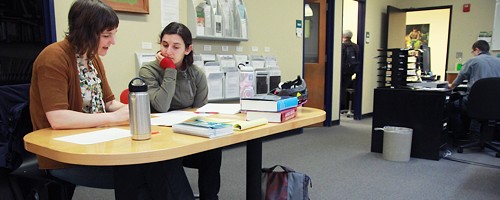Portland State has a new vision for global education. The university recently released the Strategy for Comprehensive Internationalization, a report that establishes an eight-year framework for how PSU plans to become a more globally focused institution.
Strategies for a global university
Portland State has a new vision for global education. The university recently released the Strategy for Comprehensive Internationalization, a report that establishes an eight-year framework for how PSU plans to become a more globally focused institution.
“The creation of this strategy follows from a recognition that we live in a global society now. All of the things that a university does need to fit into that context,” explained Provost and Vice President for Academic Affairs Roy Koch.
The strategy focuses internationalization efforts on six priority areas: student learning, faculty research, institutional infrastructure, internationalization of the local region, leveraging global engagements and mobilizing international alumni.
The strategy was created by the International Council, a group of more than 20 faculty, staff and student representatives from all of PSU’s different academic colleges and institutes. According to the council’s chair, Professor Vivek Shandas, this internationalization strategy was two and a half years in the making.
“This strategy tries to help coordinate, integrate and then ultimately disseminate all the internationalization efforts happening on campus,” Shandas said.
He claimed that, unlike a lot of universities, PSU has a multitude of international activities taking place on campus—but these activities have no overarching coordination. The university knows that international learning is happening, they just aren’t sure exactly who’s teaching what.
“Portland State has a lot of international activities, and they tend to be very disparate, or not coordinated in a campus-wide manner,” Shandas explained. “What we’re trying to do with this strategy is say, ‘How can we be comprehensive about internationalization and all the efforts that are trying to link Portland State University with the rest of the world and the world to Portland State University.’”
The strategy proposes several different methods for PSU’s internationalization. The main tenets include increasing international curriculum for students, expanding opportunities for faculty to conduct international research and increasing the number of international students coming to PSU and the number of PSU students studying abroad.
More ideas include the further development of strategic relationships in target regions of the world—specifically the Middle East and East Asia—and the engagement of the greater Portland community with the rest of the globe.
What these goals may actually look like when implemented is a different story. The strategy is just that—a strategy. It lays out what it calls “illustrative activities”: possibilities for ways in which internationalization goals could be realized.
“This is a vision, it’s not a plan,” Shandas reiterated.
As far as curriculum is concerned, the strategy does not advocate for the creation of more international studies courses. Instead, it focuses on ways in which professors can integrate international material into existing classes in all academic departments.
“I think that one way students will see this strategy affect their education will be in the classroom. There will be a more concerted effort to show perspectives from other parts of the world,” Shandas said.
Additionally, he claimed that with the growth of the international student population PSU students will have more opportunities to learn from those who grew up in different social, political and educational contexts.
Professor James Grehan, director of the Middle East Studies Center and member of the International Council, said that increased international curriculum can only benefit PSU students.
“In an ever more interconnected world, students need a truly global perspective on the knowledge that they are acquiring, so that they can be more sophisticated citizens,” Grehan said. “A more international curriculum will also be better at providing them with the skills, such as language training, which will turn them into more effective and sought-after workers in an increasingly globalized economy,” he added.
The strategy identified specific target regions of the world for more focused development. The two biggest areas distinguished by the strategy are the Middle East and East Asia. Koch, Shandas and Grehan all agreed that focusing on specific regions of the world is an important part of the internationalization strategy.
“To really have a strong internationalization strategy, you really need to have some areas of focus. It can’t be all of the world all the time; you need to develop connections that are deeper,” Koch explained.
These regions were chosen because, historically, the majority of PSU’s international students come from the Middle East and East Asia. PSU also has real academic expertise in these areas, as evidenced by the several different Asian and Middle East studies institutes and nationally and internationally recognized faculty members.
“PSU needs to establish itself in regions like the Middle East and build long-term academic and policy partnerships, which will bring greater recognition and investment and provide more opportunities to highlight all the knowledge and expertise that we have here on campus,” Grehan said.
An additional way this strategy will affect student education is through outside engagement, both abroad and domestically. According to Shandas, one of the priorities of the strategy is to connect students studying abroad with international alumni. Furthermore, as PSU engages the Portland community in its internationalization efforts, Portland companies with global operations may provide jobs and internships for students.
“The world is a big place—people have projects all over the map. Part of the approach that the council is taking is that we can’t be everywhere all at once, especially if we have limited resources,” Shandas said.
The report, available for viewing on the Office of International Affairs website, does lay out some fairly grand plans, which raise questions about potential funding.
Koch emphasized that the strategy mostly works within the existing funding system. While some of the proposed projects do require outside funding, a majority of them just require a shifting of resources.
“Some of these things require additional funding, but we’re always evaluating and revising the curriculum. In this case, when we’re evaluating and revising the curriculum we want to revise it in a way that includes a stronger global learning component. That doesn’t necessarily cost more money,” Koch said.
The International Council plans to review and modify the strategy annually as it learns more about which aspects of the document are successful and which need improvement.
“We are but one entity that attempts to link Portland and the Northwest to the world. What this strategy is trying to do more of is being more explicit about the role that PSU plays in linking the Northwest to the world,” Shandas said.




